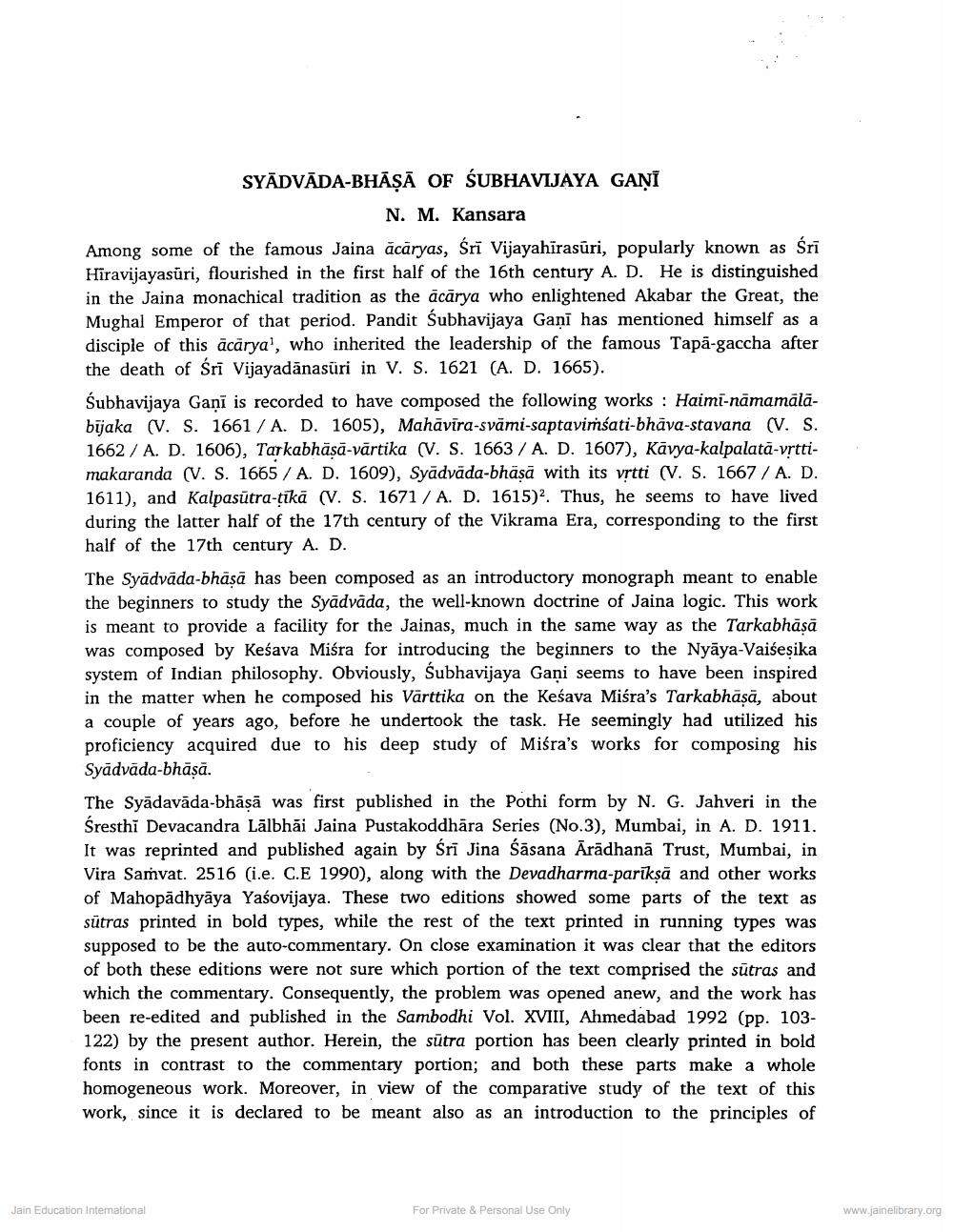________________
SYADVADA-BHAŞĂ OF SUBHAVIJAYA GANI
N. M. Kansara
Among some of the famous Jaina ācāryas, Sri Vijayahirasüri, popularly known as Śrī Hiravijayasuri, flourished in the first half of the 16th century A. D. He is distinguished in the Jaina monachical tradition as the ācārya who enlightened Akabar the Great, the Mughal Emperor of that period. Pandit Subhavijaya Gani has mentioned himself as a disciple of this äcärya', who inherited the leadership of the famous Tapå-gaccha after the death of Śrī Vijayadānasūri in V. S. 1621 (A. D. 1665).
Subhavijaya Gani is recorded to have composed the following works: Haimi-nämamäläbijaka (V. S. 1661/A. D. 1605), Mahavira-svämi-saptavimsati-bhava-stavana (V. S. 1662/A. D. 1606), Tarkabhāṣā-vārtika (V. S. 1663/A. D. 1607), Kavya-kalpalată-vṛttimakaranda (V. S. 1665 / A. D. 1609), Syādvāda-bhāṣā with its vṛtti (V. S. 1667 / A. D. 1611), and Kalpasūtra-ṭīkā (V. S. 1671/A. D. 1615)2. Thus, he seems to have lived during the latter half of the 17th century of the Vikrama Era, corresponding to the first half of the 17th century A. D.
The Syādvāda-bhāṣā has been composed as an introductory monograph meant to enable the beginners to study the Syädväda, the well-known doctrine of Jaina logic. This work is meant to provide a facility for the Jainas, much in the same way as the Tarkabhāṣā was composed by Kesava Miśra for introducing the beginners to the Nyaya-Vaiśeşika system of Indian philosophy. Obviously, Subhavijaya Gani seems to have been inspired in the matter when he composed his Värttika on the Kesava Miśra's Tarkabhāṣā, about a couple of years ago, before he undertook the task. He seemingly had utilized his proficiency acquired due to his deep study of Miśra's works for composing his Syādvāda-bhāṣā.
The Syadavāda-bhāṣā was first published in the Pothi form by N. G. Jahveri in the Śresthi Devacandra Lālbhai Jaina Pustakoddhāra Series (No.3), Mumbai, in A. D. 1911. It was reprinted and published again by Śrī Jina Sasana Aradhana Trust, Mumbai, in Vira Samvat. 2516 (ie. C.E 1990), along with the Devadharma-parīkṣā and other works of Mahopadhyāya Yaśovijaya. These two editions showed some parts of the text as sūtras printed in bold types, while the rest of the text printed in running types was supposed to be the auto-commentary. On close examination it was clear that the editors of both these editions were not sure which portion of the text comprised the sutras and which the commentary. Consequently, the problem was opened anew, and the work has been re-edited and published in the Sambodhi Vol. XVIII, Ahmedabad 1992 (pp. 103122) by the present author. Herein, the sutra portion has been clearly printed in bold fonts in contrast to the commentary portion; and both these parts make a whole homogeneous work. Moreover, in view of the comparative study of the text of this work, since it is declared to be meant also as an introduction to the principles of
Jain Education International
For Private & Personal Use Only
www.jainelibrary.org




